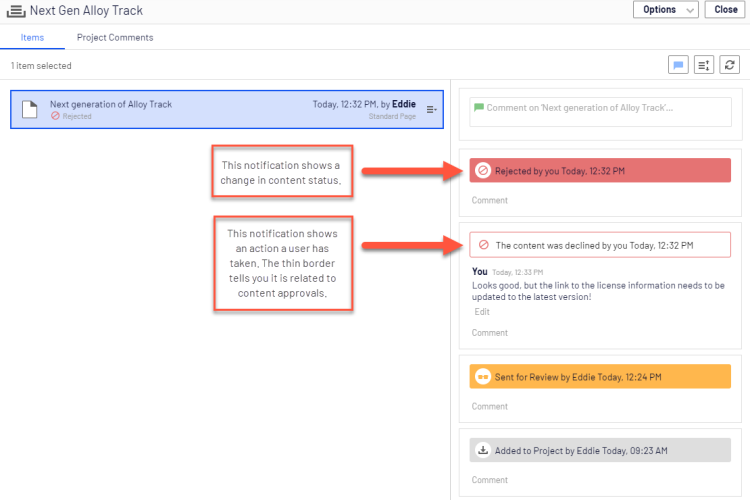 Content approvals
Content approvals
Content approvals is a way to make sure that content is reviewed and approved before it is published. When an editor has finished working on a content item, the item is set to Ready for Review. One or more appointed reviewers must then approve the content item before it can be published. The reviewers are defined by an administrator in an approval sequence.
There are three video tutorials on the Content approvals feature. The first one is a basic demo of the feature and describes how to set up an approval sequence and a basic review scenario. The second video describes how you can set up different reviewers for different languages when you have a multi-language site. It also shows you how content approvals can be combined with comments and projects. The third video describes how content approvals work for blocks and media. It also highlights the use of multi-language sites, projects and notifications features.
How it works
Sequences and reviewers
An approval sequence can be set up with any number of approval steps and any number of reviewers in each step. The sequence is set up by an administrator; as described in Managing approval sequences.
The approval sequence administrator also defines, for each step individually, who can approve a content item. It is possible to have only one person as reviewer in a step, but it is recommended to have at least two (per language) in case one of them is unavailable.
The administrator can prevent editors from approving their own changes, which means that appointed reviewers are not allowed to approve any review requests they have started themselves. However, they can still cancel their own review requests.
As soon as one of the reviewers in a step approves the content, that step is considered completed and the item moves to the next step in the approval sequence. When a content item enters an approval step, the reviewers in that step are notified by email and in the user interface that they have an item to approve. The editor who started the approval sequence is notified when the last reviewer approves the content item and it is set as Ready to Publish, or if an reviewer rejects the content item. When the content is approved in all steps, it is automatically set as Ready to Publish, and anyone with publishing rights can publish it.
The approval sequence overview is opened from a page's or assets folder's context menu:
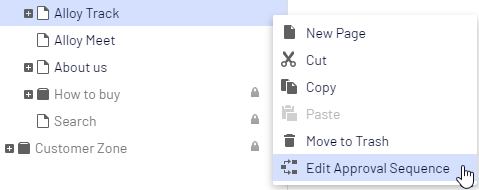
Editors can normally view an approval sequence but not change it. If an administrator has set an approval sequence on a node in the page tree, editors without administrator rights cannot by-pass the approval sequence. The Publish button is replaced by a Ready for Review button, and setting a content item to Ready for Review starts the approval sequence.
Content approvals on assets
Each page in Optimizely can have its own content approval sequence. Assets, such as blocks and media (and also forms and catalogs if you have Optimizely Forms and Optimizely Commerce respectively installed), cannot have individual approval sequences. Instead, the content approval sequence is set on each assets folder, and all assets in a folder have the same approval sequence set. Global and site-specific assets folders can inherit their approval sequence from a parent folder, or an administrator can define a unique sequence for it (or disable it completely so that assets in the folder do not have to be approved). Local assets folders inherit their approval sequence from the page they are associated with. See Folders for a description of global, site-specific and local folders.
Moving folders and assets that have content approval sequences set, works like the following descriptions.
Folders
- Moving a folder to another global or site-specific folder. The folder keeps its original approval sequence. You can move the folder even if items in the folder are in review.
- Moving a folder to a local assets folder. The folder's approval sequence is changed to the local assets folder’s sequence. You cannot move the folder if items in the folder are in review.
Assets
- Moving an asset to a global or site-specific folder. The approval sequence on the asset is changed to the new folder's approval sequence. You can move an item even if it is in review. However, it continues its original content approval sequence until it is approved or rejected. After that it has the same approval sequence as the new folder.
- Moving an asset to a local asset folder. The approval sequence on the asset is changed to the new folder's approval sequence. You cannot move the asset if it is in review.
The Blocks and Media folders in the assets pane are actually the same folders in the software and share the same content approval sequences; the Blocks and Media tabs in the assets pane are merely a way of filtering out blocks if you are in the Media tab and vice versa. This means that if Adam is set as a reviewer on block folder Bunnies, Adam is also a reviewer of all media in media folder Bunnies.
As a result, if you edit a block in the Bunnies folder which links to images in the media folder Bunnies, and set the block to Ready for Review, the same content approval sequence is triggered also for the images.
Forms and catalogs have their own structures, so even if you have a Commerce catalog named Bunnies, it does not get the same content approval sequence as the Bunnies folders for blocks and media.
If you are working on a multi-language site, items such as images that do not have a language set can be approved by any reviewer (even by reviewers that only have access to a specific language). Example: You have a site in English and German (where English is the master language The language in which the first version of content is created.) and you have set up the approval sequence so that reviewer Julia is responsible for the German content items but not the English items. You keep a folder with the two images Party_teaser_EN.png and Party_teaser_DE.png for an English and a German version, and Julia is an designated reviewer in the approval sequence on this image folder. Julia can then approve all images in the folder even if the Party_teaser_EN.png is only used on English pages, which she does not have access to.
Assets added to an assets folder with a content approval sequence set are not auto published.
Multiple languages
If you have content in more than one language, each language must have at least one reviewer. The administrator decides whether a reviewer can approve content for all languages or for specific languages. Therefore, it is possible to have different reviewers for different languages.
Each language version can be set as Ready for Review and approved separately from the other language version. This means that the German version of an item can be approved in three approval steps and published before the French version has even passed approval step 1. See Translating content to work with different languages.
Example: Content approval sequence with multi-languages
In this example, there are three reviewers in step 1, one for each of language (this is for simplicity only, in reality you should have at least two reviewers per language). In step 2, there are two reviewers, who have access rights to approve all languages. If one of the reviewers declines the content, that language version is set as Rejected and needs to be set as Ready for Review again.
Approval rejections
If a reviewer does not approve a page and declines it, the page returns to being an editable draft (with status Rejected). The responsible editor must update the page and set it to Ready for Review again. The approval sequence then starts over, and the reviewer of the first step in the approval sequence must approve it again, even if that reviewer had approved the first draft and it was a reviewer in a later step who rejected the page.
Notifications
If you have started a content approval sequence by setting an item to Ready for Review, or is set as a reviewer, you receive notifications in the user interface. The bell icon in the toolbar displays the number of new notifications you have; click the icon to display a list of notifications. From the notification list, you can go to the item that needs to be reviewed.
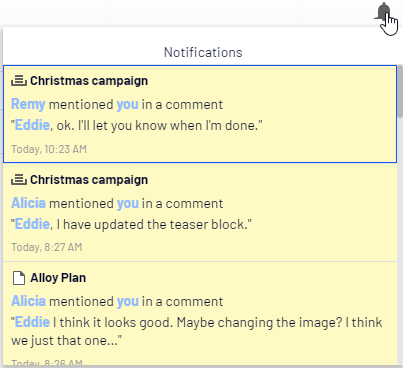
If your system is configured to use email notifications, you will also receive an email; how often these notifications are sent depends on the system configuration.
| Notifications are sent when: | To: | Notification message: |
|---|---|---|
| an item is set to Ready for Review. | the reviewers in the first step. |
"Awaiting your approval or one of Z others. Step X of Y" (if there are multiple reviewers in the step) or "Awaiting your approval. Step X of Y" (if there are only one reviewer in the step). |
| an item was approved in a step. | the reviewers in the next step. |
"Awaiting your approval or one of Z others. Step X of Y" (if there are multiple reviewers in the step) or "Awaiting your approval. Step X of Y" (if there are only one reviewer in the step). |
| all steps were approved and the item is set as Ready to Publish. | to the user who started the content approval sequence. | "The reviewed content has been approved and is now ready to publish." |
| a content approval step was declined. | to the user who started the content approval sequence, and to all reviewers in current and previous steps. | "Declined by *username*". |
| a content approval sequence was cancelled. | to all reviewers in current and previous steps. | "Review request canceled by *username*". |
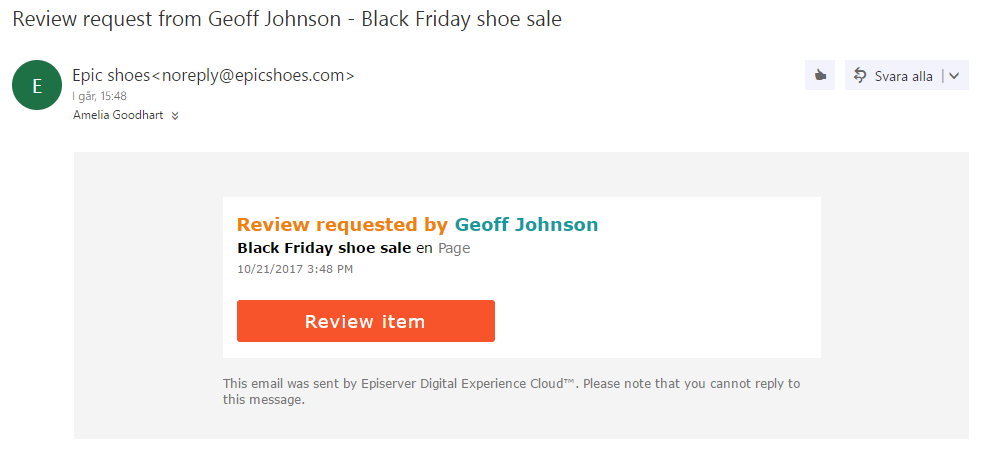
The title of the email shows that it is a review request, and you can see who requested the review. You can also see the title of the item to be reviewed (Black Friday shoe sale), the language of the item (en, which stands for English), the item type (Page) and when the review was started (10/21/2017 3:48 PM). Click Review item to open the item.
Tasks
To keep track of the content items you have sent for review, items that are waiting for your approval or items you have already approved, use Tasks in the navigation pane.
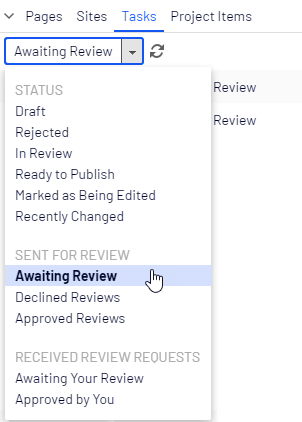
Options related to content approvals in Tasks
| Option | Description |
|---|---|
| In Review | Lists all content items that are set as Ready for Review. |
| Awaiting Review | Lists the content items that you have sent for review and are in content status In Review. |
| Declined Reviews | Lists the content items that you have sent for review and are declined, that is in content status Rejected. As soon as the item is updated, it is not displayed in this list anymore. |
| Approved Reviews | Lists the content items that you have sent for review and are approved, that is in content status Ready to Publish. As soon as the item is published (or updated), it is not displayed in this list anymore. |
| Awaiting Your Review | Lists the content items that you are one of the designated reviewers of. |
| Approved by You | Lists the content items you have approved. As soon as the item is published (or updated), it is not displayed in this list anymore. |
What happens if a reviewer is away and cannot approve?
To avoid content getting stuck in an approval step if a reviewer is unable to approve, it is recommended that you have at least two reviewers (per language) in a step.
An administrator can approve and publish a page at any time.
Administrators and the editor who started the approval sequence can cancel the approval sequence at any step.
Example: Content approval sequence in two steps
Web editor Tina works in the Marketing department and has prepared a new product launch. An approval sequence is set up for the Marketing pages, and when Tina is done, she does not have the Publish option. Instead, she must set the new product page to Ready for Review. The page is now locked for further editing and according to the predefined approval sequence, one of the company's chief editors Alicia and Carlos, must review and approve the page. Alicia and Carlos are notified with an email and also when they log in to Optimizely CMS that they have a page to approve.
When Alicia or Carlos has reviewed the page, she or he approves it.
The approval sequence now states that Steve or David needs to approve the page. They are both notified by email and in the user interface. As soon as one of them has approved the page, it is set to Ready to publish. The approval sequence is now done and any editor (or administrator) with publishing rights to the content can publish it. Tina, who started the approval sequence, is notified.
If Steve or David declines the approval, the content is set as Rejected and Tina must update it and set it to Ready for Review again. Alicia or Carlos will then have to approve the second draft as well.
Working with approval sequences
Starting an approval sequence
If an approval sequence is defined for the content you are working on, you cannot publish directly. Instead, you have to start the approval sequence by clicking Publish? > Ready for Review.
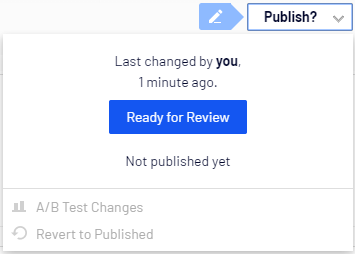
When a content item is in review, its status changes to In review in the Versions gadget. Until it is approved in all steps of the approval sequence, it is locked for editing. When it is approved in all steps, it is set as Ready to Publish, and you are notified of this both in the user interface and by email.
Image: Review icon in page tree
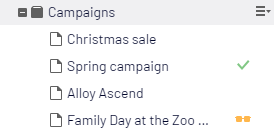
Image: Versions gadget shows In review status
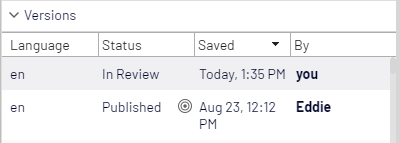
Approving or declining an approval step
If you are set as reviewer for a content item, you are notified in the user interface and by email (if the system is configured to send out emails) when it is ready for your review. Click the user notification or the link in the email to open the content item. If there is a previous version of the content item you want to review, you can use the compare feature to see where changes have been made.
When you have reviewed the content item, click Approve? and then either Approve Changes or Decline Changes. You may have to give a reason for approving or declining the content item.
If you approved the content item, it moves to the next step in the approval sequence, or if you were the last reviewer in the sequence, it is set as Ready to Publish.
If you declined the content item, it is set as Rejected and the editor needs to update the content and set it to Ready for Review again.
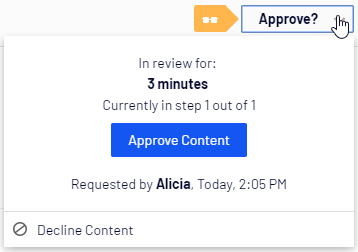
If you have multiple review requests to go through, you can use the Tasks pane to see which items you should review and to go between them, and the compare feature to see where changes have been made.
Canceling an approval sequence
You can cancel an approval sequence that you have started regardless of which step the content item is in. Click Options > Cancel Review Request and Edit. You can now edit the content again. When done, you have to set it as Ready for Review and the approval sequence starts over from step 1.
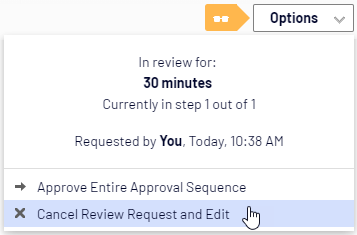
Commenting when approving and declining content
When approving or declining content and depending on your system configuration, you may have to give a reason for your action. This comment is visible in the user interface and email notifications to the person who started the content approval sequence. It is also displayed in the project overview, if the content item in review is associated with a project.


